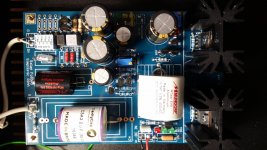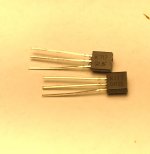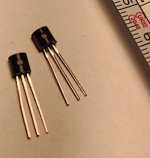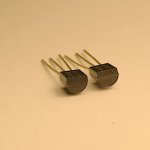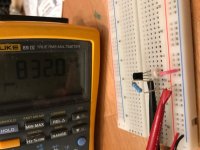You're good SalasDoes the bad channel show the expected input load value when you measure across its input RCA with the ohmmeter when the power is off?
Thanks for your help and patience Salas.
That's 1% matching. Not bad. You probably tested with less than 1mV RMS because the gain with double K369 is >1000. Unless its an MM configuration build that has x100. In general for DC checks have about 4V TP2 to GND, about 10V Q4 Drain to GND. 10-13V across DS of Q5 or Q6. Usually the more is across Q6.
*Check that R8 and R10 have the right values (6.8K & 47R)
*Check that R8 and R10 have the right values (6.8K & 47R)
We have guests this weekend so very limited time. I intended to build with maximum gain for my LOMC Denon 103pro, unless I've missed something. Another photo attached in case there's anything obvious. I'll check the gain again, but the volume sounds about right, not a factor of 10 out anyway.
The colour bands of R8 and R10 check as 47R and 6.8k.
BTW the sound is opening up nicely now it has a few hours on it .
.
The colour bands of R8 and R10 check as 47R and 6.8k.
BTW the sound is opening up nicely now it has a few hours on it
Attachments
Impossible to have good volume with a Denon 103 and having the wrong gain. An experimental error during the signal test most likely.
So the resistors are the proper ones. I was just wondering about that R10 voltage drop difference you mentioned at first so that is why I told you to have a look in the resistor values.
The 103 is a musical and big sounding cart. I have an 103R that I load with 200R or 220R. You should load the pro at 390R or more I guess.
My AT33PTGII is more neutral and resolute but the Denon is still always musically fulfilling. Especially on Jazz.
So the resistors are the proper ones. I was just wondering about that R10 voltage drop difference you mentioned at first so that is why I told you to have a look in the resistor values.
The 103 is a musical and big sounding cart. I have an 103R that I load with 200R or 220R. You should load the pro at 390R or more I guess.
My AT33PTGII is more neutral and resolute but the Denon is still always musically fulfilling. Especially on Jazz.
You're right again. My old sig gen is a bit flakey - on closer examination it's seen better days. But it was free. I've fiddled with it and managed to get some better looking results. For 1mV in (as best I could tell) there's 2.019V and 2.065V on the 'good' and 'bad' channels, an error of 2.2%. Not quite as good, but not one I could hear.
I measured across R10 again and curiously got a different reading this time - 23.62V and 23.39V good and bad respectively. Which look pretty good. I'm a little stumped why this might be, but at least it's in the right ballpark now.
The 103 pro is a nice cartridge, building on the stock 103 but it's a lot less fussy on setup. It works well with my 12" Schroeder-type arm. I much prefer it to my Kontrapunkt b which sounds a little thin in comparison.
Any recommendations for a cheap sig gen?
I measured across R10 again and curiously got a different reading this time - 23.62V and 23.39V good and bad respectively. Which look pretty good. I'm a little stumped why this might be, but at least it's in the right ballpark now.
The 103 pro is a nice cartridge, building on the stock 103 but it's a lot less fussy on setup. It works well with my 12" Schroeder-type arm. I much prefer it to my Kontrapunkt b which sounds a little thin in comparison.
Any recommendations for a cheap sig gen?
GW Instek SFG-1013. I used to have one and it was fairly good in general and very good for the price. Produces a decent and smooth square to test any audio amp. Uses DDS tech. Goes to 3MHZ. If you can make the jump to their AFG-2005 its much more than worth the difference though. Don't consider Ebay super cheap gen wonders in any case. They are ringy and jumpy no matter what they claim.
Your phono build looks like working well from what you describe. Exact mV readings and percent can be difficult to catch steady if the gen is playing up also. Denon 103xx and FSP make a nice combo in my experience. The smooth open loop stages JFET rendition complements the upper mid enthusiasm of the cart. They can be very musical together. You will also figure out optimum resistive loading and VTA best fit for the combo soon. If you can't exactly "lock" the tone there is also C2Y to tamper with as last resort. Takes some time to fine tune a system. Let us know.
Your phono build looks like working well from what you describe. Exact mV readings and percent can be difficult to catch steady if the gen is playing up also. Denon 103xx and FSP make a nice combo in my experience. The smooth open loop stages JFET rendition complements the upper mid enthusiasm of the cart. They can be very musical together. You will also figure out optimum resistive loading and VTA best fit for the combo soon. If you can't exactly "lock" the tone there is also C2Y to tamper with as last resort. Takes some time to fine tune a system. Let us know.
I'm using the basic 390R loading, I use 39k with 10x SUT so I was pretty comfortable starting with 390R. Maybe 10 years ago I was breadboarding a valve phono and included 2 12-way rotary switches so I could change loading on the fly, and it was an illuminating experience. I agree loading is important.
The FSP really does sound very good indeed I must say. I wanted to see what affects removing the SUTs might have, and whilst it's not exactly a scientific comparison I'm liking it a lot . I had Buena Vista Social Club on earlier, normally I'm told to "turn it down" but this time I was greeted by salsa dancing and not a word about volume. That's got to be a good sign
. I had Buena Vista Social Club on earlier, normally I'm told to "turn it down" but this time I was greeted by salsa dancing and not a word about volume. That's got to be a good sign  .
.
The FSP really does sound very good indeed I must say. I wanted to see what affects removing the SUTs might have, and whilst it's not exactly a scientific comparison I'm liking it a lot
SK117's
Salas,
I have 30 SK117's. I have a couple around 5.4mA that i will try for Q7. From the rest, two are ~2.8mA and the rest are above 5.5, with the majority in the 6mA to 7mA range. Are any of these useable for the regulator or do I need to scavenge for more?
-Thanks, David
Salas,
I have 30 SK117's. I have a couple around 5.4mA that i will try for Q7. From the rest, two are ~2.8mA and the rest are above 5.5, with the majority in the 6mA to 7mA range. Are any of these useable for the regulator or do I need to scavenge for more?
-Thanks, David
SK117's
Photos attached. i bought a batch of 20 a several years ago (I don't recall where, but probably eBay) and another batch of 10 on Amazon 2 months ago. I thought there would be a chance the latter would be fake, but I thought the older batch would be ok.
Photos attached. i bought a batch of 20 a several years ago (I don't recall where, but probably eBay) and another batch of 10 on Amazon 2 months ago. I thought there would be a chance the latter would be fake, but I thought the older batch would be ok.
Attachments
You have to watch for the sharp, laser cut writing now. What you are looking for are slightly messy stamped information with a date code that makes sense. Another warning are compliments that have the same date code. That doesn't often happen in real life for hobbyists.
I often buy test batches from Ebay to see how bad things are. They're pretty bad out there. If you can find a current transistor that will work, use it. The promise of lower noise and higher transconductance won't be found in the land of fakes.
I really miss the good 2SC1775A and 2SA970A transistors. I used to use them all the time. Now it looks like surface mount stuff is the last good supply of devices.
-Chris
I often buy test batches from Ebay to see how bad things are. They're pretty bad out there. If you can find a current transistor that will work, use it. The promise of lower noise and higher transconductance won't be found in the land of fakes.
I really miss the good 2SC1775A and 2SA970A transistors. I used to use them all the time. Now it looks like surface mount stuff is the last good supply of devices.
-Chris
I checked my records and the seller i bought from on eBay is in the US. They are still selling them. Maybe I am measuring wrong. I will post a picture.
The resistor is 100R.
What's that number on the Fluke; Its dark. Is it 832mV? Means 8.32mA when across 100R. No way for a proper K117GR. Your connections on the breadboard look right for the purpose.
- Home
- Source & Line
- Analogue Source
- Simplistic NJFET RIAA

